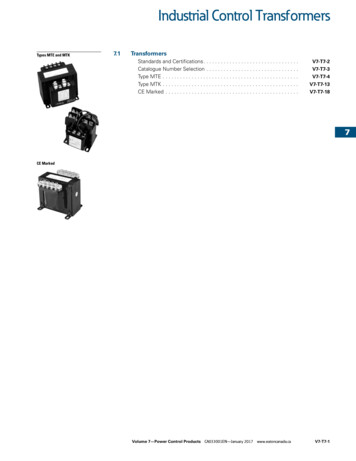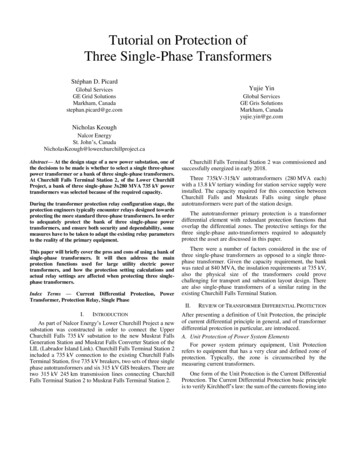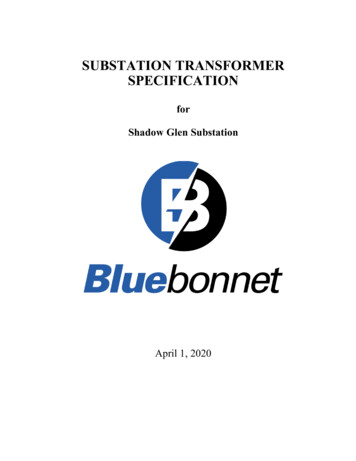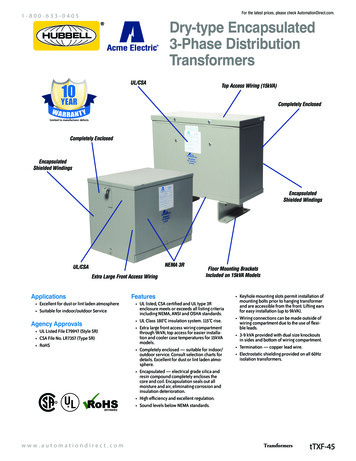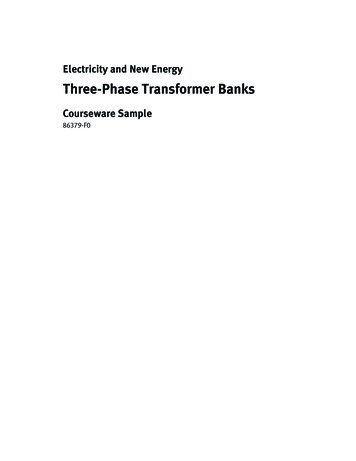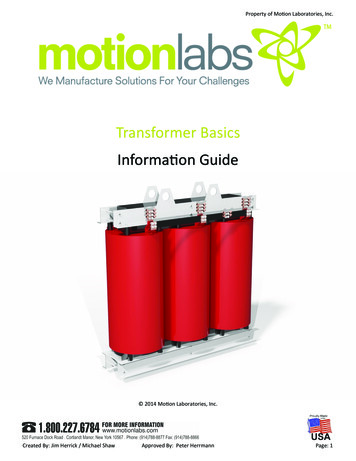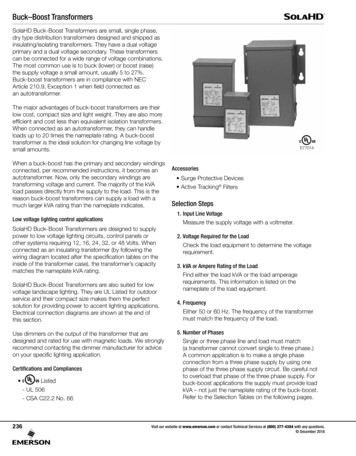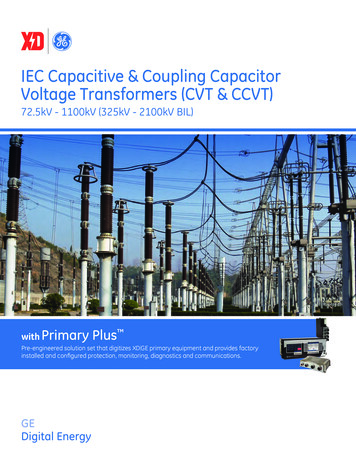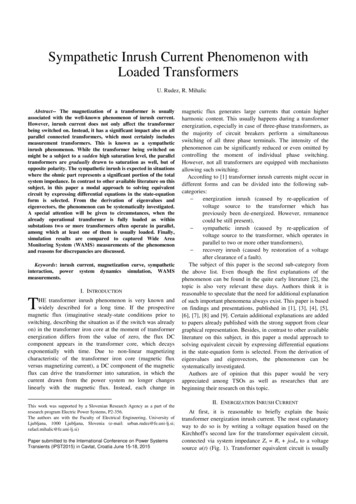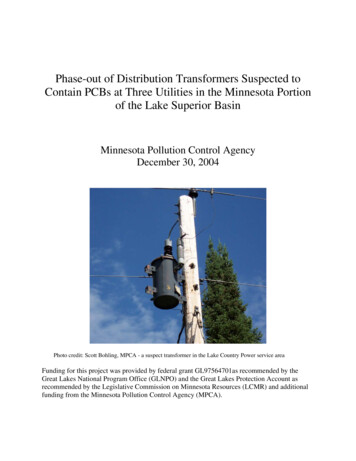
Transcription
Phase-out of Distribution Transformers Suspected toContain PCBs at Three Utilities in the Minnesota Portionof the Lake Superior BasinMinnesota Pollution Control AgencyDecember 30, 2004Photo credit: Scott Bohling, MPCA - a suspect transformer in the Lake Country Power service areaFunding for this project was provided by federal grant GL97564701as recommended by theGreat Lakes National Program Office (GLNPO) and the Great Lakes Protection Account asrecommended by the Legislative Commission on Minnesota Resources (LCMR) and additionalfunding from the Minnesota Pollution Control Agency (MPCA).
Table of ContentsPageExecutive Summary .Introduction Project Description Identifying the Suspect Transformers Pre-Testing versus Not Pre-Testing . .Tagging the Transformers .Replacing the Transformers .Costs .Funding .Results Lessons Learned and Recommendations. .Acknowledgements 1222446788910TablesTable 1.Table 2.Table 3.Table 4.Number of transformers in each category .Costs associated with transformer change-out Funding sources for the project .Number of transformers being removed as part of the project 3789FiguresFigure 1. Location of suspect transformers in the Lake Country Power andCooperative Light and Power service areas . . 5Figure 2. Example of a high priority suspect transformer in the CLPservice area . 6Figure 3. Grand Marais Public Works director and linemen . 7AppendicesAppendix A. List of Lake Country suspect transformers(sorted by distance to water) . 11Appendix B. List of Cooperative Light and Power suspect transformers(sorted by distance to water) . 18Appendix C. Grand Marais Test Results . 24
Executive SummaryManufacture of polychlorinated biphenyls (PCBs) has been discontinued but use of PCB bearingequipment continues. PCBs are one of nine toxic chemicals targeted by the Lake Superior ZeroDischarge Demonstration. This project’s objective was to assist owners of small quantities ofPCBs to remove contaminated distribution transformers in the Lake Superior watershed. Four utilities shared their transformers’ serial numbers with the Minnesota PollutionControl Agency. The agency compared their serial numbers to manufacturing serialnumbers. 638 transformers (3 to 4% of all transformers in the four utilities) were on themanufacturers’ list of transformers that may contain PCBs.The MPCA visited each of the suspect transformers in the Lake Country Power andCooperative Light and Power service areas within the Lake Superior watershed. Thecoordinates were entered in a GPS unit and the closest body of water was also entered.This allowed the MPCA to prioritize transformers using the distance to water.Lake Country Power volunteered to remove all of their 292 suspect transformers,although the contract could cover only a portion of the cost.Similarly, Cooperative Light and Power contracted to purchase 145 transformers toreplace the suspect transformers manufactured by General Electric (GE) that were closestto Lake Superior. (Suspect GE transformers are highly likely to contain PCBs and aretherefore a priority.)The City of Grand Marais contracted to replace 14 suspect transformers and test others.This project and voluntary actions by participants will result in the replacement of 82% ofthe suspect transformers owned by the three facilities that participated and 71% of thesuspect transformers originally identified at all four utilities. (Arrowhead Electric Powerdid not participate in the final stage.)1
IntroductionPolychlorinated biphenyls (PCBs) were once commonly used as dielectric fluids in electricalequipment. Manufacture of PCBs was discontinued in 1977, two years before a federal ban onmanufacturing. The Toxic Substances Control Act (TSCA) allows the continuing use of certainPCB bearing equipment, but the disposal of the oils from this equipment is strictly regulated.When transformer manufacturers switched from PCB to non-PCB fluids, the new transformerswere filled using the same equipment that had been used for PCBs. The result was that someolder transformers contained high concentrations of PCBs while newer transformers werecontaminated with various levels of PCBs, depending on how long the filling equipment hadbeen flushed with non-PCB fluids.Because of the highly persistent, bioaccumulative and toxic nature of PCBs, this group ofchemicals has been included on a variety of lists of toxic chemicals targeted for source reduction,including the Great Lakes Water Quality Agreement (GLWQA), the Great Lakes Water QualityInitiative (GLI), the Canada Ontario Agreement Respecting the Great Lakes (COA), theBinational Toxics Strategy (BTS) and the Lake Superior Binational Program to Restore andProtect the Lake Superior Basin (LSBP). The LSBP includes a Zero Discharge Demonstrationfor nine toxic chemicals, including chlordane, DDT, dieldrin, dioxin, hexachlorobenzene,mercury, octachlorostyrene, PCBs and toxaphene.As a participant in the LSBP, the Minnesota Pollution Control Agency proposed a project to findand remove as many PCB contaminated transformers as possible. The tentative goal was toremove half of the suspect transformers. The project was funded through a combination ofsources, including the Great Lakes National Program Office (GLNPO), the LegislativeCommission on Minnesota Resources (LCMR) and the Minnesota Pollution Control Agency(MPCA). The project focused on the smaller utilities in the Lake Superior basin since MinnesotaPower, the largest utility in the region, already has a PCB phase-out plan.Project DescriptionIdentifying the Suspect TransformersManufacturers have supplied lists of transformer serial numbers which contain PCBs or arelikely to contain PCBs. The MPCA obtained this list of “suspect” transformers fromElizabethton Electric System, an electric utility in Tennessee. A hard copy of ElizabethtonElectric’s list (i.e., Distribution Transformer Manufacturers and Available Polychlorinated (PCB)Information) is available from the MPCA. They had prepared a list for quick identification oftransformers suspected of containing PCBs for their line workers.They also identified the likelihood that particular manufacturers’ transformers on the listsactually were contaminated. They found the transformers most likely to contain PCBs weremade by GE, Westinghouse and Wagner. With further refinements with using information fromthe manufacturers, Elizabethton Electric was able to narrow down the range of serial numbersand increase “hits” (i.e., PCBs greater 50 ppm) by using specific sections of serial numbers.2
The confidence levels for each manufacturer increased dramatically. Based on the furtherdevelopment of the query by Elizabethton Electric, 70% of all GE transformers, 72% of allWagner transformers, and nearly 100 % of all Westinghouse transformers on the lists arecontaminated with 50 ppm PCBs. The MPCA used this specific serial number data to come upwith queries for the Minnesota database.The MPCA also contacted nine facilities that had responded to a voluntary 1997 surveyindicating that they owned PCB transformers. Each contact included a certified letter that gaveparticipants a guarantee that the PCBs removed as part of the project would not be subject toMinnesota hazardous waste fees. The agency discovered that some of the facilities had sinceremoved all their PCB transformers (i.e., the City of Virginia and Bend Tech, Inc.). We alsofound that the City of Biwabik had its own utility, but the City was unable to take advantage ofthe project because they were in the process of trying to sell the utility.Ultimately, we worked with four utilities, who shared their transformer inventories with theagency. An MPCA student worker developed a database and compared the inventories to themanufacturers’ list of suspects. The first three utilities analyzed included the City of GrandMarais, Arrowhead Electric Cooperative and Cooperative Light and Power. 6,852 transformerswere run through database queries to separate non-PCB transformers from those that mightcontain PCBs. Of the 6,852 transformers evaluated, 346 tripped the queries. This is a rate of5.0% transformers identified as suspect, although rates at individual utilities ranged from 3.6 to9.2%. Table 1 summarizes how many transformers were found in each of the three inventories.Table 1. Number of transformers in each category.UtilityGrand 207Mod. Likely03962101Test ,5064,1846,852To elaborate on the results of this table: 207 of the 346 (60%) were classified as Highly Likely to contain 50 ppm PCBs. Theseare General Electric (GE), Wagner, and Westinghouse transformers. 101 of the 346 (29%) were classified as Moderately Likely to contain 50 ppm PCBs.These transformers are made by various other manufacturers. Elizabethton Electricfound these other manufacturers had much less contamination. 37 of the 346 (11%) were classified as Test First. These transformers are Allis Chalmers.Other possibilities include Duncan, Pittsburgh, Packard, and American Corp., althoughnone of these have been found in the Lake Superior transformer inventory, yet.Lake Country Power is the fourth utility whose inventory was analyzed. This was the largestutility in the project, with approximately 35,000 distribution transformers. Unlike the otherutilities, which are mostly within the Lake Superior basin, about 70% of Lake Country’stransformers are outside the Lake Superior basin. This utility had 292 transformers within the3
basin that tripped the database query. This works out to a rate of suspect transformers in thebasin of roughly 2.8%. Adding these transformers to the ones in Table 1 gives an overall rate of3.7%. Of the 292 suspect transformers, 63% were classified as Highly Likely, 36% wereclassified as Moderately Likely and only 1 transformer was in the Test First category.Pre-Testing versus Not Pre-TestingOriginally it was believed that it would be most effective to test suspect transformers beforereplacing them since replacement and disposal is expensive. In some cases (e.g., the City ofVirginia) this has already been done. A bucket truck is brought to the transformer, power is cutbriefly while a lineman cuts a hole through the transformer with a Hilty gun or a special drill,pipettes out a sample and reseals the transformer.As we progressed in negotiations with the utilities, it became clear that this may not be aseffective as first thought. The main concern expressed by the utilities was going to the sametransformer twice if it turned out to contain PCBs. The cost of a crew and tying up a buckettruck is also expensive. Inconvenience to the customer also has to be figured in as well as thearrangements a utility makes to prepare customers for a brief loss of power. Plus, thetransformers that are on the suspect list are quite old by now and some are due for replacementby more efficient units. Also, some utilities are concerned about using a sampled transformeralthough others have used them and have not had any problems due to the sampling holes.The end result was that neither of the contracts with Lake Country Power or Cooperative Lightand Power called for pre-testing transformers. However, the City of Grand Marais wanted to doadditional testing. The City had replaced some transformers already as part of a roadrealignment project. In checking the oil analyzes, the director of Public Works found atransformer that was not on the suspect list that did test positive for PCBs. Under thesecircumstances and given the small size of the Grand Marais inventory, it seemed reasonable totest more transformers, even those not on the suspect list.There may be other good reasons to pre-test. For example, the City of Biwabik’s records did notinclude the serial numbers of their transformers, making it impossible to compare to themanufacturers’ list. If this utility were to participate in a similar project in the future, the firststep needed would be testing all the transformers in this small town (population 954).Tagging the TransformersIt was clear at the onset of this project that there was insufficient funding to replace all thesuspect transformers in the basin. The MPCA student worker tagged the transformers with aGlobal Positioning System (GPS) unit and also tagged the closest waterbody. Suspecttransformers closest to water became the highest priority. Figure 1 shows a map of all the LakeCountry Power and Cooperative Light and Power transformers that were tagged for this project.Note that 28 of the tagged Lake Country Power transformers turned out to be outside the LakeSuperior basin and 16 of the Cooperative Light and Power basin transformers were outside thebasin, which demonstrates the usefulness of GPS tagging for watershed-specific projects such asthis. Also, because the transformers are so close together, some points on the map are overlaid.4
5
Replacing the TransformersTo their great credit, Lake Country Power decided to use the contract money for purchasing thenew transformers and they would take on the remaining costs, including taking down the oldtransformer, hanging the new one, testing the oil and disposing of the old transformer. In thisway, they covered all their distribution transformers in the Lake Superior basin (see AppendixA). As of November 2004 they had replaced over half of the transformers.Figure 2. Example of a high priority suspecttransformer in the CLP service area.Also to their credit, Cooperative Lightand Power (CLP) made a similardecision but chose to replace 145 GEtransformers, which are in the HighlyLikely category. (CLP has 241 suspecttransformers.) As mentioned above,the CLP transformers were tagged withGPS so the 145 GEs closest to waterbecame the highest priority forreplacement (see Appendix B). TheMPCA provided this list of highpriority transformers to CLP. Figure 2shows one of these high prioritytransformers near the shore of LakeSuperior.Photo credit: Michael Taylor, MPCAAlthough the contracts with the MPCA only covered the cost of the replacement transformers,the utilities have agreed that they will share the test results with the agency. We anticipate theresults will be available sometime in late spring or early summer since the utilities will use thenon-construction season to hang the new transformers and get the old ones tested and disposed.The MPCA will prepare an addendum to this report when the results are available.Note that timing is important with this type of project. The utilities are extremely busy duringthe construction season and are not able to put much physical effort into a phase-out project,although they can negotiate contracts, order equipment and so on. After the construction season,they can do the work of actually replacing the transformers. This work comes to an end with thespring thaw when weight restrictions are put on the county roads and the bucket trucks can nottravel on them.Grand Marais removed 13 suspect transformers and tested others. While Grand Maraisoriginally had 15 suspects, some transformers were removed as part of highway work before thecontract started. Figure 3 shows the Grand Marais crew who worked on the project.6
While we are still waiting for the Lake Country Powerand Cooperative Light and Power testing results, somedata are available from Grand Marais and aresummarized in Appendix C. Of the 11 suspecttransformers tested in Appendix C, 6 had concentrations 50 ppm PCBs but did not exceed 500 ppm. The othersuspects were 50 ppm. Six other transformers alsotested out between 50 and 500 ppm but were NOT on thesuspect list. Since none of the serial numbers of theselast 6 corresponds to the inventory that was originallysupplied to the MPCA, this confirms the importance of 1)having a complete inventory and 2) the value of pretesting in small utilities or ones with incomplete records.Surprisingly, of these 6, one is NOT on GE’s list ofsuspect transformers. GE does note in its materialssupplied to Elizabethton Electric that their list is“approximate and subject to many exceptions.” Of the 12that contained 50 ppm PCBs, 9 were made by GE andother 3 were Westinghouse. Half of the 50 ppmtransformers were 25 KVA although sizes of thecontaminated transformers ranged from 7.5 to 150 KVA.Figure 3. Grand Marais PublicWorks Director and linemen.Photo Credit: Mike Taylor, Grand MaraisAlthough the MPCA and Arrowhead Electric Cooperative negotiated and the company wascooperative, we were not able to produce a contract in a satisfactory time period due to fundingdeadlines. This utility would be a good candidate for a future project.CostsCosts include several categories. Besides the cost of administering the project, the actual cost ofphasing-out transformers includes replacement, disposal, labor and testing. Table 2 shows sometypical costs for replacement, disposal and testing at Grand Marais. The cost of labor will varydepending on the utility and the transformer situation. 21 per hour for labor was acceptable.Table 2. Costs associated with transformer change-outSize10 KVA15 KVA25 KVA50 KVAReplacementTransformer* 267 320 423 620Disposal of OldTransformer 212 245 349 545Testing Oil forPCBs 12 12 12 12* equipment such as AMP cutouts, lightening arrestors, compression connectors and new wire should be replaced atthe same time, adding about 70 per transformer to the overall cost.Using this information, a typical 15 KVA transformer change-out would cost about 650 dollars,not including labor, taxes or hazardous waste fees.7
FundingTable 3 summarizes how the three sources of funding were used for contracts for the phase-outproject. In the future, we would like to pursue funding to assist Cooperative Light and Power,Arrowhead Electric Cooperative, the City of Biwabik and any remaining contaminatedtransformers in the City of Grand Marais system.Table 3. Funding sources for the project.UtilityAllotmentnumberGrand MaraisCooperativeLake CountryTotalContract #A-60982A-59805A-57519NALCMR200-K21ZWP6 51,568 35,432 87,000StateTSCAMatch330-K22YH01 25,0981 6,182 31,280GLNPO300-K21ZWP3 22,666 22,6662Total 36,3001 57,750 58,098 152,1481Grand Marais was able to spend 25,098 of the 36,300 allotted in the contract. We are evaluating a secondcontract for 11,200 to finish the work.2The total GLNPO grant was 50,000. The remainder was for staff, fringe, indirect, supplies and printing.ResultsDue to the funding made available by GLNPO and the LCMR, the MPCA was able to make atotal of 152,148 available to utilities for phasing-out distribution transformers that had thepotential to be contaminated with PCBs. The three utilities that contracted with the MPCA to dothe work each took a slightly different route. Lake Country Power completely eliminated thepotential liability. Cooperative Light and Power eliminated the risk in over half of its suspecttransformers and is taking out those closest to water. Grand Marais tested as well as removedtransformers in their system.Table 4 describes the final numbers from this PCB phase-out project. Note that the tentativegoal of removing half of the suspect transformers was easily met, although this was only possibledue to the actions taken by the utilities. The grant funding would have been insufficient by itself.More specifically, 82% of the transformers at the three participating utilities will be phased-out.However, once the Arrowhead Electric Cooperative inventory is added, the percent reductionfalls to 71%, which still exceeds the original goal.As mentioned previously, when Lake Country Power and Cooperative Light and Power testresults are available, the MPCA will prepare an addendum to this report. We expect to have aclearer understanding of what the actual rate of PCB contaminated transformers is compared tothe suspect list. For example, 3-4% of the transformers in the inventories were on the suspectlist, but how many actually were contaminated at a level of 50 ppm or more? We will also havea better understanding of which types (i.e., manufacturers and sizes) of transformers in the basinare most likely to be contaminated.8
Table 4. Number of transformers being removed as part of the project.UtilityLake CountryPowerCooperativeLight and PowerCity of nd TotalPercentReduction292Number ofTransformersBeing 890452082%0%17,35263845271%Number ofTransformers inthe LakeSuperior basin110,500Number ofSuspectTransformers100%1 approximateLessons Learned and Recommendations: Contract directly with the utilities rather than a disposal company: Utilities that own theirdistribution systems will probably prefer to either do the work themselves or usesubcontractors of their own choosing. Allot more time for the seasonal nature of the project: While some small utilities mightbe able to spend time on a project such as this at any time of the year, there is typically abusy season (i.e., construction season) and a slower winter season. Start negotiations inwinter, go on hiatus during construction season and allow another winter (or even two,depending on the quantity of transformers) for the work. Be prepared to track multiple funding sources: This project had multiple funding sources,which was difficult to track under the current MPCA system. The MPCA shouldconsider linking such allotments and treating them as one unit with several subsets. Don’t separate known versus suspect transformer phase-out efforts: Unnecessary timewas spent investigating the possibilities of a disposal contractor. In the end, the contractswent directly to the utilities who then focused on the transformers identified as suspects. Biwabik needs help: Since they were in the midst of negotiations on selling their utility,the City was not able to participate in this project. In addition, the Biwabik inventory isunsuitable for comparing to manufacturing information since they do not have a list ofserial numbers for their in-service transformers. The City would benefit from a two-partproject to test all the transformers (similar to what the City of Virginia did) and thenremove those that contain PCBs. There are still suspect transformers left standing: Although it was known at the onset thatthere was insufficient funding to handle all the suspect transformers and the utilities weregenerous in their participation, there are still suspect transformers at Cooperative Lightand Power and Arrowhead Electric Cooperative in the Lake Superior watershed that werenot be tested or removed as part of this project.9
Look for opportunities to change-out other types of PCB bearing equipment: While it isreasonable to target distribution transformers since leaking transformers can contaminatenearby waters, capacitors, substation transformers, bushings and some other types ofelectrical equipment also contain PCBs.Electric cooperatives are mostly willing to meet us partway: The participating utilities aretaking on some of the financial burden of change-outs, which means that the state andfederal funding dollars stretched further than originally anticipated. The tradeoff is thatthe negotiation time took longer than anticipated and results will consequently takelonger.Environmental stewardship awards would be appropriate: The MPCA will be seekingopportunities to nominate the utilities for their efforts.AcknowledgementsThis report was prepared by Carri Lohse-Hanson, the MPCA Lake Superior Binational ProgramCoordinator, with the assistance of student workers Scott Bohling and Michael Taylor. Theauthor would like to thank Lake Country Power, Cooperative Light and Power, ArrowheadElectric Cooperative and the City of Grand Marais for their cooperation and participation. Thefollowing individuals were especially helpful:Bill Bussey and Madelyn Mesich at Lake Country Power;Tom Dahlstrom and Bonnie Tonkin at Cooperative Light and Power;Jon Cress at Arrowhead Electric Cooperative; andMike Taylor, Don Davison, Matt Bronkowski and John Twiest at Grand Marais.Thank you!10
Appendix A. List of Lake Country suspect transformers (sorted by distance to water).Manufacturer andSerial NumberAB AB ChanceD DowzerGE General ElectricLM Line MaterialM MoloneyMG McGraw EdisonW WagnerDistance toWaterM 1312881M 1223B54GE B629601W 5M32404GE H350482P73GE L465935P73M 1212867LM 3C102006GE H37265P73AM 1105266DGE 9814026GE B171832GE B136393GE B182947GE H399012P74LM 4G54222M 1194429GE H373241P73LM 6K70219WGE B117750LM 4F54115GE H374753P73GE H398295P74GE B106890GE B122519LM 839647GE B107534GE B144888GE H391353P74M 1199946GE B181762GE H398250P74GE H398962P74GE B177963GE B179915GE B897030GE H372697P73GE 150154155Position( feet )N47.46003 W92.37107N46.92459 W92.49356N47.14927 W92.39999N46.92318 W92.17675N47.20806 W92.34654N47.30454 W92.32342N47.09658 W92.52573N46.86119 W92.41220N47.21075 W92.34941N46.85437 W92.41486N47.22029 W92.21231N47.22129 W92.21109N47.37820 W92.26153N47.22365 W92.22719N47.38876 W92.25166N46.37518 W92.66098N47.09005 W92.54406N47.08864 W92.54199N46.89500 W92.45250N47.21829 W92.21784N46.39346 W92.52190N47.35288 W92.59793N47.41496 W92.77553N47.31536 W92.44969N47.22741 W92.40441N46.95668 W92.21664N47.46234 W92.31424N47.46405 W92.31546N47.45947 W92.37683N47.09832 W92.40478N47.31334 W92.98002N47.41688 W92.29198N47.37244 W92.64627N47.16785 W92.31289N47.20986 W92.36129N47.35490 W92.88162N47.31893 W92.82924N46.39599 W92.5878811
GE B171377GE B123838GE B158925GE B107084GE B117517LM 354415LM 407291LM 7L50663AGE B123841GE B833421GE H398233P74LM 6J750184WGE B289960LM 4K54361M 1190307LM 326670GE H398246P74M 121643GE F55241165PLM 354531GE H394458P74GE B621576LM 300404LM 70D50238ALM 7122005016LM 780289LM 978438M 1192024GE H450421P73GE H398986P74M 1192000LM 4F752543M 102211402GE H398313P74LM 268626GE H394472P74GE H339168P73GE H398132P74GE B-121-367GE H398125P74GE B179991GE H399143P74GE B118865GE L465934P74GE H398258P74GE H398124P74LM 644444GE 4N47.31103 W92.33041N47.16354 W92.30846N47.44080 W92.24799N47.44536 W92.32977N47.31126 W92.45150N46.82220 W92.36597N47.01178 W92.77038N46.39032 W92.60435N47.48926 W92.34150N47.14572 W92.45575N47.37166 W92.71788N46.99218 W92.32023N47.21896 W92.21546N46.39552 W92.58940N47.30169 W92.50854N46.84932 W92.40473N47.48547 W92.39010N46.39032 W92.60544N47.21544 W92.23343N46.95106 W92.90509N47.40231 W92.23956N46.39431 W92.59380N47.03832 W92.93719N46.96475 W92.31612N46.98219 W92.81215N46.96421 W92.31592N47.27956 W92.20053N47.33431 W92.41065N47.40581 W92.54248N47.47241 W92.69102N47.16362 W92.32035N46.79466 W92.92174N47.42663 W92.77054N47.33164 W92.41095N46.53740 W92.61749N47.43498 W92.35082N47.68238 W92.02495N47.26290 W92.60131N46.78683 W92.44998N47.43799 W92.34658N47.40923 W92.54096N47.49323 W92.25764N46.41803 W92.51218N47.47734 W92.69031N47.40147 W92.73826N47.44032 W92.25112N46.80106 W92.90492N47.31432 W92.6655112
LM 7122050162GE H374053P73M 1191998LM 3J752436LM 902487GE H398326P74GE B116426LM 538106GE H349474P73M 1312889GE B603582GE H372605P73GE L465926P74GE B117691GE H393741P74GE B603145M 1192006W 5L34440GE B123816GE H397472P74GE H398262P74GE H394475P74GE H373345P73LM 70BJ260016GE B156624GE H398125P74GE H383844P74GE B592199GE H37409P73ALM 511548M 1200131GE B103894GE H398291P74GE B106795M 1053995GE H383795P74LM 7022005008LM 472911M 1223B517GE H398102P74GE B116342GE B118590LM 328316GE H383826P74GE H394477P74GE H399032P74LM 823228LM N47.00163 W93.21095N47.39388 W92.25776N47.08085 W92.60415N46.87737 W92.24411N47.36243 W92.90623N47.13995 W92.59903N47.28209 W92.19351N46.44023 W92.66267N47.43838 W92.64960N47.08933 W92.54752N46.65656 W92.64822N47.48246 W92.38929N47.37248 W92.89521N47.50592 W92.62840N47.31487 W92.62820N46.83226 W92.89471N47.05002 W92.45284N46.79516 W92.30728N47.47843 W92.36153N47.30684 W93.02185N47.68653 W92.08232N47.35559 W92.97056N47.66938 W92.10665N47.08715 W93.19334N47.18440 W92.47333N47.39375 W92.47333N47.43013 W92.68676N46.65361 W92.65039N47.10432 W92.47096N46.67671 W92.34223N47.14425 W92.47139N47.46544 W92.33190N47.32711 W92.62851N47.35798 W92.70436N47.00069 W93.05147N47.44488 W92.35383N47.23926 W92.82076N46.83591 W92.33129N47.25836 W92.80878N47.08495 W92.47462N47.25640 W92.40663N46.65603 W92.64761N46.94328 W92.33896N47.41596 W92.25515N47.32911 W92.99911N47.44873 W92.35629N47.51032 W92.67150N46.82753 W92.7032613
GE H348419P73GE H391369P74LM 587087GE L465965P74GE H398317P74WG 5L34442LM 918316M 1099LM 7022010160GE H398243P74GE H399185P74GE H373200P73M 143010GE H398290P74GE H383783P74GE B136353LM 2J53243M 1113464LM 5J753864DGE B181766GE H393711P74LM 436706LM 7122005015M 106267M 1128909GE L465942P74LM 892864LM 823184M 1192933GE B603766GE H372595P73GE B171444M 149940GE B171424M 120927GE H383807P74GE B110875GE B566040LM 903218GE L466015P74W 5L38445GE B156717W 5M61117GE H348427P73LM 8L102120AGE B171478GE H373310P73GE 7N47.50656 W92.67372N47.09751 W92.59736N46.92382 W92.46591N47.34348 W93.00850N47.30816 W92.60037N47.04991 W93.23286N47.04700 W92.80420N46.99317 W92.56457N47.15758 W92.79547N47.39184 W92.24023N47.46563 W92.24748N47.40509 W92.70084N46.93873 W92.34374N47.4138
Discharge Demonstration. This project’s objective was to assist owners of small quantities of PCBs to remove contaminated distribution transformers in the Lake Superior watershed. Four utilities shared their transformers’ serial numbers with
